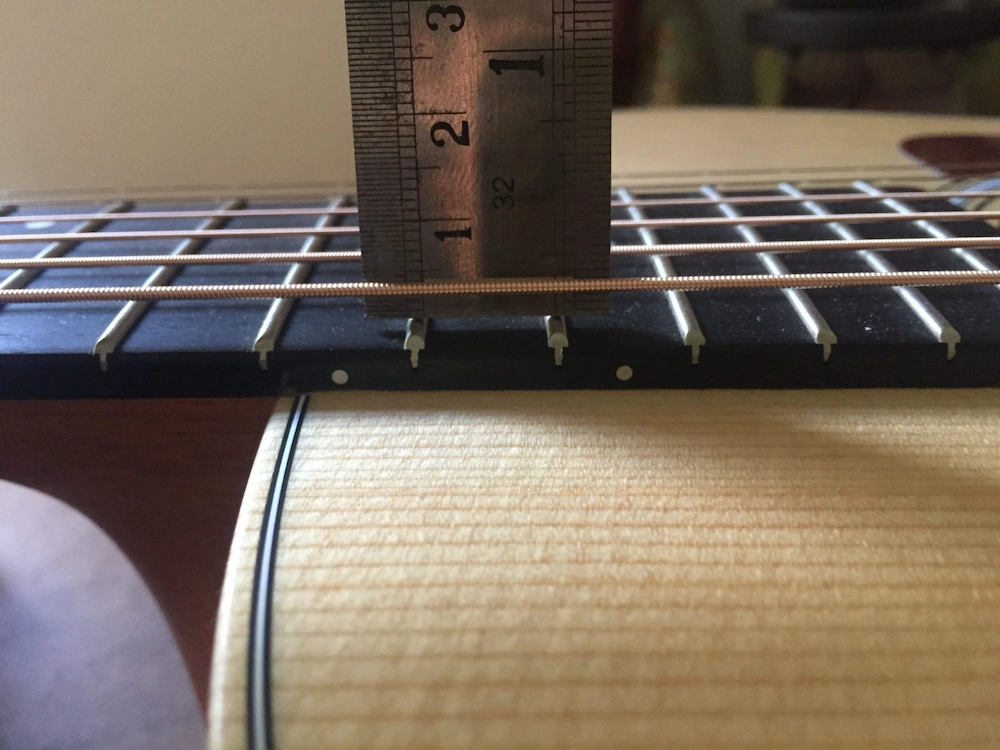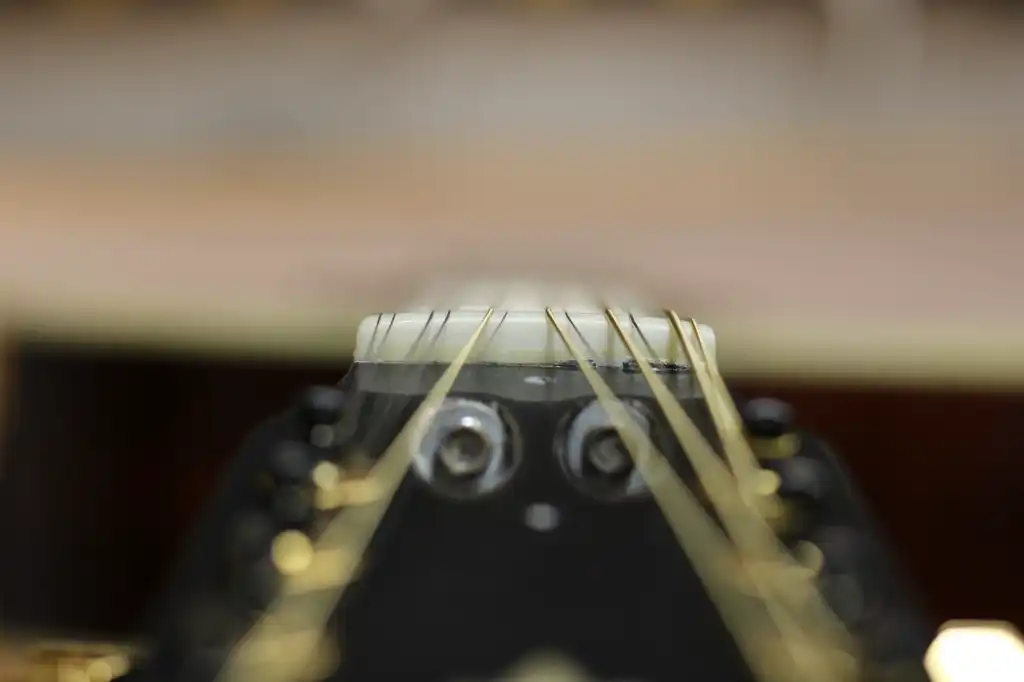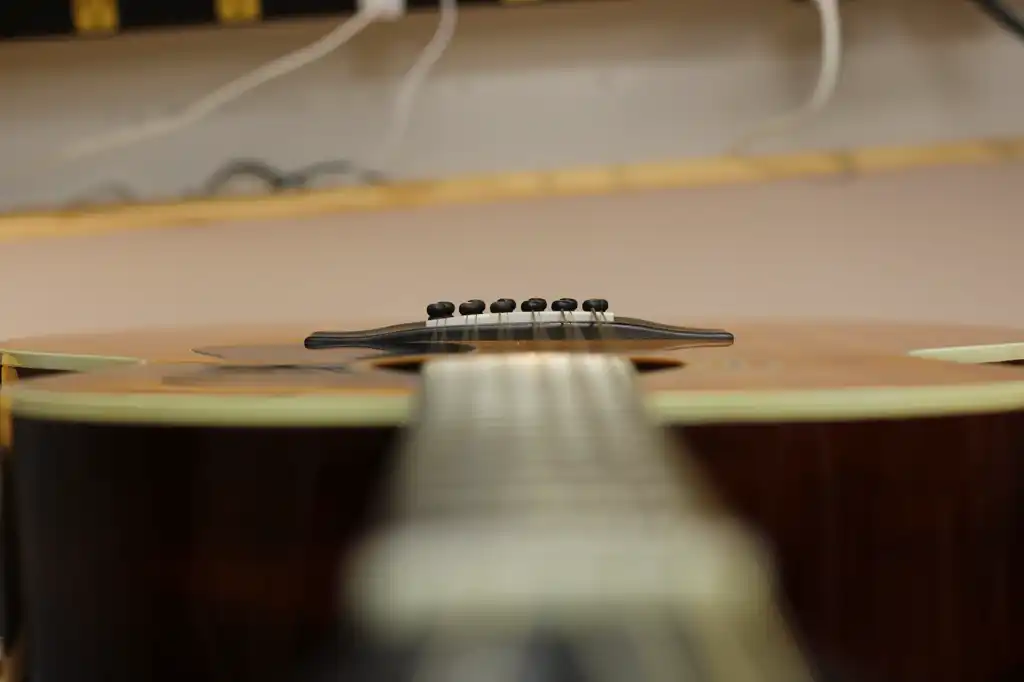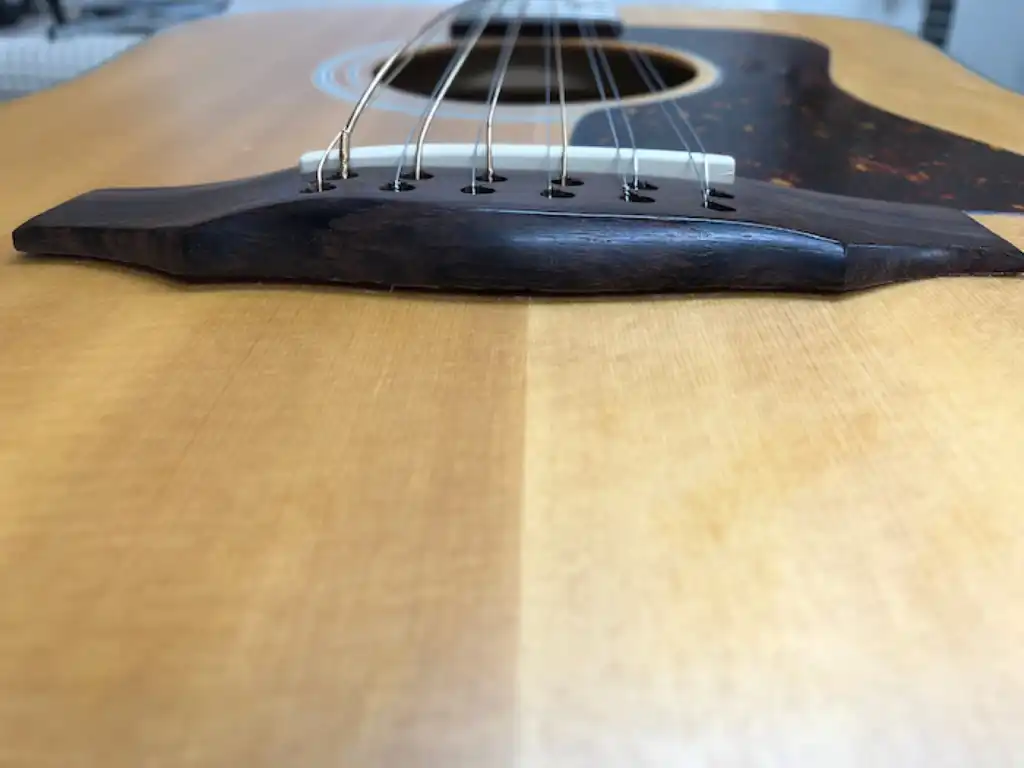Action item 1. Truss rod - I have written rather extensively about truss rods, the various types and their functionality in my article » D-Tube by DragonPlate - Truss Rod Alternative. In summary, most modern steel string acoustic guitars are fitted with adjustable truss rods that run beneath the fretboard from the nut to the neck heel. The primary function of a truss rod is to counter the tendency of the neck to bow forward. This is not to be confused with a neck stiffener, which serves only to resist forward bow, but provides no mechanical adjustability.
A compression rod is (or, in the case of older Guild 12 strings, twin compression rods are) pressed into a concave bow in deep slots in the neck, fixed into the neck heel, and threaded into a recess in the headstock. Tightening a nut/washer combination against the end grain of the neck forces the rod to straighten which, in turn, forces the neck to bow backwards. Loosening the nut (re)submits the neck to the tension of the strings and (typically) results in a forward bow. More or less.
An independent single-action (or 1-way) truss rod secures a threaded rod to a metal beam that sits as a unit in a single, shallow channel in the neck beneath the fretboard. Unlike a compression rod, it is not attached to the neck. A socket on one end may be installed at the headstock or accessed through the soundhole, depending on the builder's preference. Tightening the rod (by turning the socket clockwise) will, as with the compression rod, induce a back bow. Turning the socket counter-clockwise will, as with the compression rod, allow the string tension to pull the neck forward.
A dual-action (or 2-way truss rod) also installs in a guitar neck as an independent component, just like the single-action (or 1-way) version. However, unlike both the single-action truss rod or a compression rod, a dual-action truss rod may also be used to deliberately bow the neck forward. Why would anyone incorporate such a design when, seemingly, the strings are working to pull the neck forward? Necks having dual-action truss rods are typically built much stiffer than their predecessors (for example, carbon fiber rods are often installed on either side of the truss rod channel). Having the ability to "dial in" the desired fretboard flatness is perceived by many to be essential.
This adjustability highlights a secondary function of the dual-action truss rod, that of inducing relief, a small but deliberate forward bow in the fretboard that some builders and/or players feel is necessary to mitigate string-to-fret contact.
It is important to note that, in the case where a guitar with uncomfortably high action is determined to be suffering from too much forward bow, and that guitar is fitted with some form of adjustable truss rod, the forward bow can be reduced (or eliminated) and the action lowers proportionally.
While that may be all a player needs to restore a guitar to functionality, please realize that adjusting string action height is NOT the role of the truss rod. More on this, later.
Action item 2. Saddle - Unlike a violin or banjo, nearly all acoustic guitars feature a saddle that is fitted into a slot in the bridge. As such, it can readily be replaced when worn, or with a different material for tonal purposes. If a player has a particular action preference, and assuming the fretboard is already set to proper relative flatness, the saddle is often seen as the adjustable component to be used to raise or lower the string height.
The strings are set extremely close to the tops of the frets nearest the nut, sometimes clearing the first fret by as little as 3 to 5 thousandths of an inch. However, that distance increases exponentially as you move up the fretboard. Action is typically measured at the 12th fret, where the gap between the top of the fret and the bottom of the string may easily be 30 x greater. In cases of extremely high string action, that gap may be 50 or 60 x greater at the 12th fret than it is at the 1st fret.
Lowering the saddle height is usually accomplished by sanding or filing the bottom of the saddle in order to avoid altering any deliberate contouring for intonation purposes. Before breaking out the sandpaper, however, take a moment to familiarize yourself with some geometry. We are measuring action height at a point half-way between the nut and the saddle (typically the 12th fret). If we wish to lower the action by a said amount at that 12th fret, we must reduce the height of the saddle by that desired amount times a factor of 2. As an exaggerated example, if I wanted to lower my action (at the 12th fret) by 1/8" I would need to remove 1/4" off the height of the saddle (1/8" x 2)! If my guitar has really high action at the 12th fret, you may imagine that I am likely to quickly run out of saddle material in my attempts to make the guitar comfortable to play.
More importantly, viewing the saddle simply as a string height adjustment component ignores a significant factor that governs the overall sonic output of any given guitar: the overall string height measured in front of the bridge. More on this, later.
Action item 3. Bridge - So what if I have adjusted my fretboard to be as flat as it can go, and I have lowered my saddle down to as far as it can go, but I still have a little bit too high of a string action? Is there anything left for me to adjust? A more serious modification occasionally made in an attempt to get the string height as low as possible (not recommended, by the way) involves reducing the height of the bridge by planing, shaving and/or sanding. The idea behind this is that, in order for me to have enough saddle emerging from the surface of the bridge to get a solid string connection on, knowing I cannot raise the saddle any higher (my action height is still too high), I need to lower the bridge height.
Will resorting to such drastic measures make a guitar playable, again? Perhaps, but such playability comes at a price. The bridge is an external brace on my soundboard. Altering its size will alter the tone of my guitar. Rarely does reducing the height of an existing bridge yield positive sonic results.
Action item 4. Frets/Fretboard - Since most action height adjustment efforts involve reduce the distance between the plane of the strings and the surface of the frets, could we not simply raise the frets up closer to the strings? Installing taller frets is a viable method to attempt to return a guitar to playability. This does not work for everyone, though, as A.) We are talking about extremely small differences in height that are often insufficient to overcome extremely high action conditions, and B.) A radical adjustment in playing technique is required for the tallest of frets, and most players don't care for the "feel." It has never been my experience, nor have I ever been told by a player, that taller frets makes for a more comfortable fretboard.
A similar solution involves swapping out the fretboard with a thicker one, one that perfectly resolves both the string action height issue as well as maintains the payer's preference for fretwire. The potential downside to this is the resultant increase in overall neck depth (or "thickness"), where my favorite skinny neck nows feels chunky, along with a slight increase in weight.
If, after taking these four (4) factors into consideration, I am still left with uncomfortably high string action, what next?








